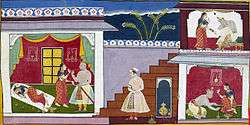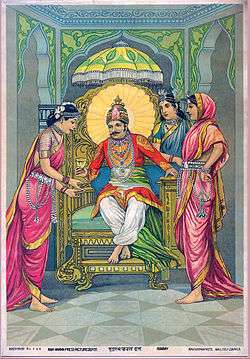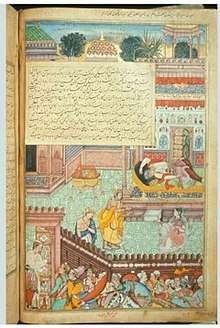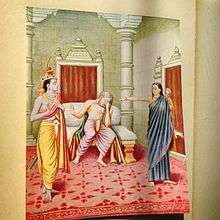Kaikeyi
Kaikeyi was the second consort of King Dasharatha and the Queen of Ayodhya in the Hindu epic, the Ramayana.
| Kaikeyi | |
|---|---|
 Dasharatha promises to banish Rama as per Kaikeyi's wishes(A folio from Ayodhya Kand manuscript) | |
| Epic | Ramayana |
| In-universe information | |
| Family | Ashwapati (father) Kausalya(sister-wife) Sumitra(sister-wife) |
| Spouse | Dasharatha |
| Children | Bharata (son) Rama (step-son) Lakshmana (step-son) Shatrughna (step-son) Shanta (step-daughter) |
Birth

Ashwapati, the mighty prince of Kekaya Kingdom became really worried that he did not have any children. He told his father, the king of the Kekaya Kingdom about this. His father asked Kekaya Dynasty's royal priest about the childless life of his son. The royal priest told that the royal family should serve the Sages who were living in Rishi Varsha and which was surrounded by Aryavartha or Aryavarsha and Sthreevarsha. The King of Kekaya and Ashwapati went to Rishi Varsha to serve the Rishis. One of the sages was pleased with the service of the King and the prince of Kekaya. He prayed to Lord Surya to bless the prince with children. Lord Surya appeared and blessed Ashwapati with a son and a daughter. His wife became pregnant and twins were born to them at Arkakshetra. The rishi named the boy Yudhajit and the girl Kaikeyi. The king of Kekaya Kingdom spent a few years with his grandchildren and died due to illness. After the death of the King, Ashwapati became the King of Kekaya Kingdom, Yudhajit became the prince of Kekaya Kingdom and Kaikeyi became the princess of Kekaya Kingdom.[1]
Relations




Kaikeyi's nature and her relationships are quite revealing in Ayodhya Kand of Valmiki Ramayan.[2] Kaikeyi maintained strong relations with her maternal family even after her wedding to King Dasharath. Her brother Yudhajit visits her many times and takes a keen interest in the life of her son Bharata, often taking Bharata and Shatrugna away to Kaikeya kingdom for vacation.
Kaikeyi was a strong woman and was with her husband Dasharath in Dandaka forest while he was at war. While Kaikeyi saved the king in the war, as per mythology her left hand was strong as diamond (a boon from a Saint) so the king accompanied her during wars.
Kaikeyi was the king's favourite queen. Kaikeyi's nature is described as being temperamental and unpredictable. While mostly she was sweet mannered, it is evident that she disliked the king spending time with his other queens. King Dasharatha mentions that he did not treat his queen Kausalya deservedly due to fear of Kaikeyi's tantrums.
Kaikeyi seemed almost naive when it came to understanding the rights of the four princes to Ayodhya's throne. She naively mentions to her maid Manthara that Bharata can rule Ayodhya after Rama, not really understanding the genealogical inheritance to the throne. It is Manthara who educates Kaikeyi of the rights to ascension to the throne.
Kaikeyi's naive nature and sweetness was transformed into obstinacy and power-hunger; all in the name of her son Bharata's welfare. Bharata contests her views vociferously and despises her for her act of banishing the rightful heir Rama to forests as if punishing him for no fault of his. King Dasharath tries to reason with her in terms of internal security of the kingdom, people's will, the Court's decision to crown Rama; none of which seems reasonable to her. Dasharath appeals to Kaikeyi to give the kingdom to Rama which was in her powers but she fails to do so. Finally, king Dasharatha renounces her, yet he is unable to separate himself from her. He lingers on in grief in her chambers for fear of humiliation from everyone outside those chambers.
Notes
References
- ramanan50 (17 February 2017). "Kaikeyi Born In Russia World During Ramayana Part 3".
- "Valmiki Ramayana". Valmiki Ramayana. Retrieved 12 June 2017.
.jpg)